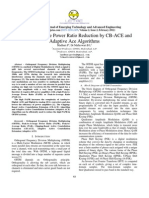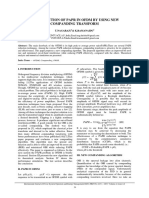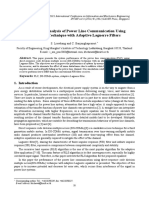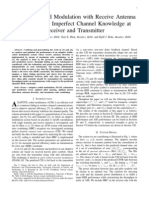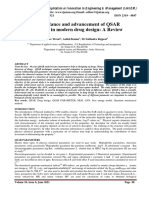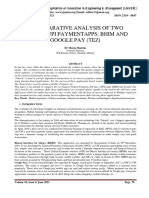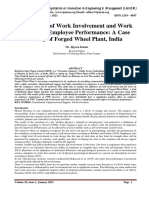0 ratings0% found this document useful (0 votes)
36 viewsBER and PAPR Reduction Using Companding Algorithms in OFDM
BER and PAPR Reduction Using Companding Algorithms in OFDM
International Journal of Application or Innovation in Engineering & Management (IJAIEM)
Web Site: www.ijaiem.org Email: editor@ijaiem.org, editorijaiem@gmail.com
Volume 3, Issue 1, January 2014 ISSN 2319 - 4847
Copyright:
Attribution Non-Commercial (BY-NC)
Available Formats
Download as PDF, TXT or read online from Scribd
BER and PAPR Reduction Using Companding Algorithms in OFDM
BER and PAPR Reduction Using Companding Algorithms in OFDM
0 ratings0% found this document useful (0 votes)
36 views5 pagesInternational Journal of Application or Innovation in Engineering & Management (IJAIEM)
Web Site: www.ijaiem.org Email: editor@ijaiem.org, editorijaiem@gmail.com
Volume 3, Issue 1, January 2014 ISSN 2319 - 4847
Original Title
IJAIEM-2014-01-20-046
Copyright
© Attribution Non-Commercial (BY-NC)
Available Formats
PDF, TXT or read online from Scribd
Share this document
Did you find this document useful?
Is this content inappropriate?
International Journal of Application or Innovation in Engineering & Management (IJAIEM)
Web Site: www.ijaiem.org Email: editor@ijaiem.org, editorijaiem@gmail.com
Volume 3, Issue 1, January 2014 ISSN 2319 - 4847
Copyright:
Attribution Non-Commercial (BY-NC)
Available Formats
Download as PDF, TXT or read online from Scribd
Download as pdf or txt
0 ratings0% found this document useful (0 votes)
36 views5 pagesBER and PAPR Reduction Using Companding Algorithms in OFDM
BER and PAPR Reduction Using Companding Algorithms in OFDM
International Journal of Application or Innovation in Engineering & Management (IJAIEM)
Web Site: www.ijaiem.org Email: editor@ijaiem.org, editorijaiem@gmail.com
Volume 3, Issue 1, January 2014 ISSN 2319 - 4847
Copyright:
Attribution Non-Commercial (BY-NC)
Available Formats
Download as PDF, TXT or read online from Scribd
Download as pdf or txt
You are on page 1of 5
International Journal of Application or Innovation in Engineering& Management (IJAIEM)
Web Site: www.ijaiem.org Email: editor@ijaiem.org, editorijaiem@gmail.com
Volume 3, Issue 1, January 2014 ISSN 2319 - 4847
Volume 3, Issue 1, January 2014 Page 188
ABSTRACT
Orthogonal Frequency Division Multiplexing is an attractive technology for wireless communication. It offers high spectral
efficiency, power efficiency and multipath delay tolerance. The nonlinear characteristics of high power amplifiers are very
sensitive to signal amplitudes. OFDM is a multicarrier scheme in which number of carriers is added coherently, when they added
together it increases average power of signal amplitudes. High average power leads to distortion in operation of system. This
effect is known as peak to average power ratio (PAPR) is a major drawback of orthogonal frequency division multiplexing
(OFDM) systems. In literature many techniques were developed to reduce Bit error rate and PAPR. Among the various PAPR
reduction techniques, companding transform appears attractive for its simplicity and effectiveness. In this paper, evaluation of
performance of companding algorithms -law companding, Exponential companding, companding Airy function is compared
in terms of bit error rate and peak to average power ratio.
Keywords: Bit error rate, -law companding, Peak to average power ratio, nonlinear companding transform.
1. INTRODUCTION
Orthogonal Frequency Division Multiplexing is a multicarrier transmission technique, it divides available spectrum
into many carriers. OFDM uses spectrum much more efficiently by spacing the channels much closer to each other. This
system has better properties such as high spectral efficiency, robustness to channel fading, immunity to interference.
There are some obstacles in OFDM system. A major problem is that OFDM signal exhibits a very high peak to average
power ratio (PAPR). These large peaks cause saturation in power amplifiers, intermodulation amongst subcarriers,
increases out of band interference. Therefore it is necessary to reduce PAPR.
To reduce the peak to average power ratio several technique have been proposed such as clipping [3], [4], coding, peak
windowing, tone reservation [6]. But most of these technique are unable to achieve simultaneous a large reduction in peak
to average power ratio with low complexity. Among all these techniques the simplest solution is to clip transmitted signal
when its amplitude exceeds a desired threshold. Clipping highly non-linear process however, it produces significant out
of band interference (OBI). A good remedy for out of band interference is called companding. The technique soft
compress, rather than hard clips, the signal peaks causes far less out of band interference. The method was first
proposed in, which employed in classical - law transform and showed effective. Since then many different companding
transform with better performance have been published.
This paper organized as follows: section 2, presents companding algorithms such as law, Exponential, Companding
using airy function. In section three these algorithms compared with non-companded signal. We use bit error rate and
peak to average power ratio as a comparison parameter for companding algorithm. In section four we conclude.
2. Companding algorithm
Figure 1 Block diagram OFDM system with companding algorithm.
BER and PAPR Reduction Using Companding
Algorithms in OFDM
A. N. Jadhav
1
, M. V. Kutwal
2
1
Associate Professor, Electronics Department, D.Y. Patil College of Engineering & Technology, Kolhapur, India.
2
Assistant Professor, E&TC Department, D.Y. Patil Technical Campus, Talsande, Kolhapur, India
International Journal of Application or Innovation in Engineering& Management (IJAIEM)
Web Site: www.ijaiem.org Email: editor@ijaiem.org, editorijaiem@gmail.com
Volume 3, Issue 1, January 2014 ISSN 2319 - 4847
Volume 3, Issue 1, January 2014 Page 189
2.1 -Law Companding
Law is a simple but effective companding technique to reduce the peak-to-average power ratio of OFDM signal.
The idea comes from the use of companding in speech processing. Since OFDM signal is similar to speech signal in the
sense that large signals only occur very infrequently, the same companding technique might be used to improve OFDM
transmission performance [7],[8].
A QAM-OFDM system diagram is shown in Figure .1. The incoming bit stream is packed into x bits per symbol to
form a complex number where x is determined by the QAM signal constellation. For a real sequence output at the
IDFT, the complex input to the IDFT has Hermitian symmetry and is constrained as follows
(1)
Where k=0, 1, 2 (N/2)-1, and S(0)=0.
Suppose N is even and , the output of IDFT is
(2)
n=0, 1,2.,N-1
The law companding technique can be then introduced. The samples of OFDM signal s(n) are companded before it is
converted into analog waveform.
The signal after companding is given by
(3)
A is normalization constant, after D/A conversion the signal transmitted through channel. At the receiver end, received
signal first converted into digital form, the sampling result is
(4)
Where q is analog to digital conversion error and w is AWGN channel factor.
The expanded signal can be approximated as :
2.2 Exponential Companding
Exponential companding technique adjusts both large and small signals and can keep the average power at the same level
[9]. By transforming the original OFDM signal into uniformly distributed signals, the exponential companding schemes
can effectively reduce peak to average power ratio for different modulation subcarriers [9].Companding equation can be
given as: Let the power of amplitude of companded signal, have a uniform distribution in the interval [0,]. The
exponent is called degree of specific exponential companding scheme. The CDF of is simply
,0 (6)
Considering the phase of the input signals, the companding function h(x) is given by,
(7)
(8)
Where sgn(x) is the sign function. The positive constant determines the average power of output signals.
(9)
International Journal of Application or Innovation in Engineering& Management (IJAIEM)
Web Site: www.ijaiem.org Email: editor@ijaiem.org, editorijaiem@gmail.com
Volume 3, Issue 1, January 2014 ISSN 2319 - 4847
Volume 3, Issue 1, January 2014 Page 190
At the receiver side, the inverse function h(x) of is used in decompanding operation,
(10)
2 2. .3 3 Companding Using airy Function.
OBI is the spectral leakage into alien channels. Quantification of the OBI caused by companding requires the knowledge
of the power spectral density (PSD) of the companded signal. Unfortunately analytical expression of the PSD is in general
mathematically intractable, because of the nonlinear companding transform involved. Here we take an alternative
approach to estimate the OBI. Let (x) be a nonlinear companding function, and (t) =sin(t) be the input to the
compander. The companded signal (t) is: (t) =[(t)] = [sin(t)] . Since (t) is a periodic function with the same period
as (t), (t) can then be expanded into the following Fourier series:
(11)
Where the coefficients c (k) is calculated as:
(12)
Notice that the input x in this case is a pure sinusoidal signal, any (k) =0 for k >1 is the OBI produced by the
nonlinear companding process. Therefore, to minimize the OBI, (k) must approach to zero fast enough as k increases. It
has been shown that (k) k(m+1) tends to zero if y(t) and its derivative up to the m-th order are continuous, or in other
words, c(k) converges at the rate of k(m+1). Given an arbitrary number n, the n-th order derivative of y(t), Jny/Jtn, is
a function of Ji(x)/Jxi, (i =1, 2, , n), as well as sin(t) and cos(t), i.e.:
(13)
sin(t) and and cos(t) are continuous functions, Jny/Jtn is continuous if and only if Ji(x)/Jxi (i =1, 2, , n) are
continuous. Based on this observation : Companding introduces minimum amount of OBI if the companding function (x)
is infinitely differentiable. The functions that meet the above condition are the smooth functions. We now introduce a
smooth function, namely the airy special function. The companding function is as follows:
(14)
where airy() is the airy function of the first kind. o is the parameter that controls the degree of companding. [ is the
factor adjusting the average output power of the compander to the same level as the average input power:
(15)
Where E[] denotes the expectation. The decompanding function is the inverse of (x):
(16)
Where the superscript-1 represents the inverse operation. Notice that the input to the decompander is a quantized signal
with finite set of values. We can therefore numerically pre-compute 1(x) and use table look-up to perform the
decompanding in practice. Next we examine the BER performance of the algorithm. We can calculate BER by using
following equations. Let (t) denote the output signal of the compander, (t) the white Gaussian noise. The received signal
can be expressed as:
(17)
The decompanded signal (t) simply is:
(18)
International Journal of Application or Innovation in Engineering& Management (IJAIEM)
Web Site: www.ijaiem.org Email: editor@ijaiem.org, editorijaiem@gmail.com
Volume 3, Issue 1, January 2014 ISSN 2319 - 4847
Volume 3, Issue 1, January 2014 Page 191
Using the first order Taylor series expansion,
(19)
3. PERFORMANCE SIMULATION
From the given Equation shows that if (t) falls into the range of the decompanding function 1(u) where J1(u)/Ju
u=y(t) <1, the noise w(t) is suppressed, and if y(t) is out of the range, J1(u)/Ju u=y(t) >1 and the noise is
enhanced. Therefore, if the parameter o in is properly chosen such that more (t) is within the noise-suppression range of
1(u), it is possible to achieve better overall BER performance.
Figure 2 BER vs. SNR
Table 1: BER vs. SNR
Sr.No. SNR BER (non-
companded)
BER (-law companded) BER (Exponential
companded)
BER using airy
function
1 1 0.09 2.54 0.09 0.1
2 3 0.03 0.33 0.06 0.04
3 5 0.01 0.19 0.03 0.01
4 7 0.002 0.10 0.01 0.007
5 9 0.006 0.04 0.003 0.002
0 2 4 6 8 10 12 14
10
-1
10
0
PAPR
C
C
D
F
Exponential
Airy function
No companding
mu law
Figure 3 PAPR vs. CCDF
1 2 3 4 5 6 7 8 9 10 11
10
-4
10
-3
10
-2
10
-1
10
0
Performance analysis
-----EbNo
-
-
-
-
B
E
R
No companding
Airy function
Exponential
,mu law
International Journal of Application or Innovation in Engineering& Management (IJAIEM)
Web Site: www.ijaiem.org Email: editor@ijaiem.org, editorijaiem@gmail.com
Volume 3, Issue 1, January 2014 ISSN 2319 - 4847
Volume 3, Issue 1, January 2014 Page 192
Exponential companding possess lowest PAPR i.e. 2.8, airy companded has 4.1, and -law has 10.5. The non companded
signal has highest PAPR which causes problem in linear operation of OFDM system. It is observed that Non companded
signal has highest PAPR. -law & companding using airy function scheme gives improvement in PAPR, Exponential
scheme gives lowest PAPR as it works on high peak signals as well as small signals hence can keep average power at
minimum level. Also from table 1 airy companded signal has lowest BER than other companding techniques.
4. CONCLUSION
In this paper, performance of companding algorithms such as -law & Exponential, companding using airy function
algorithm is evaluated based on BER, PAPR. Airy companded signal has lowest BER than other companding techniques.
Non companded signal has highest peak to average power ratio. -law companded signal shows improvement in PAPR
than non-companded signal. Airy companded algorithm offers less PAPR than -law and non-companded signal.
Exponential companding scheme offers better improvement in PAPR among all these techniques as it adjusts both large
and small peaks. Thus by using airy companding scheme we can offer improved BER while reducing PAPR effectively.
References
[1.] A R. van Nee and R. Prasad, OFDM for Wireless Multimedia Communications. Boston, MA: Artech House, 2000
[2.] Ramjee Prasad ,OFDM for Wireless Communications Systems, Artech House, 2000
[3.] T. Jiang and Y. Wu, An overview: peak-to-average power ratio reduction techniques for OFDM signals, IEEE
Trans. Broadcast., vol. 54, no. 2, pp. 257-268, June 2008.
[4.] Luqing Wang and Chintha Tellambura A Simplified Clipping and Filtering Technique for PAR Reduction in
OFDM Systems, IEEE signal processing letters, vol. 12, no. 6, June 2005
[5.] Seung Hee Han, and Jae Hong Lee, Modified Selected Mapping Technique for PAPR Reduction of Coded OFDM
Signal, IEEE transactions on broadcasting, vol. 50, no. 3, September 2004
[6.] Abolfazl Ghassemi, and T. Aaron Gulliver, PAPR Reduction of OFDM Using PTS And Error-Correcting Code
Sub-blocking,IEEE transactions on wireless communications, vol. 9, no. 3, march 2010
[7.] X. Wang, T. T. Tjhung, and C. S. Ng, Reduction of peak-to-average power rat0 of OFDM system using a
companding technique, IEEE Trans. Broadcast., vol. 45, no. 3, pp. 303-307, Sept. 1999.
[8.] T. Jiang and G. Zhu, Nonlinear companding transform for reducing peak to- average power ratio of OFDM
signals, IEEE Trans. Broadcast., vol. 50, no. 3, pp. 342-346, Sept. 2004.
[9.] T. Jiang, Y. Yang, and Y. Song, Exponential companding technique for PAPR reduction in OFDM systems,
IEEE Trans. Broadcast., vol. 51, no. 2, pp. 244-248, June 2005
[10.] L.N. Bronshtein, K.A. Semendyayev, G. Musiol, and H. Muehlig, Handbook of Mathematics. Springer, 2007,
p. 422
AUTHOR
Prof. A. N. Jadhav received BE in Electronics from D.Y. Patil College of Engineering & Technology, Kolhapur in 1991,
ME degree in Electronics from walchand College of Engineering Sangli in 1997,(Ph.D. Scholar). He is currently
working as Associate Professor and HOD in D.Y. Patil College of Engineering & Technology, Kolhapur. He is a LM of
ISTE. His 33 international and 19 national research papers are published.
M.V. Kutwal completed BE from Terna College of Engineering Osmanabd in 2009 and doing M.E. ETC in D.Y. Patil
College of Engineering, Kolhapur and presently working as a Assistant Professor in D.Y. Patil Technical Campus,
Talsande, Kolhapur.
You might also like
- Convolutional Coded On-Off Keying Free-Space Optical Links Over Fading ChannelsDocument6 pagesConvolutional Coded On-Off Keying Free-Space Optical Links Over Fading ChannelsseventhsensegroupNo ratings yet
- Jyei10081 58 PDFDocument5 pagesJyei10081 58 PDFaravindhana1a1No ratings yet
- Expo CompandDocument4 pagesExpo CompandAshutosh RajopadhyeNo ratings yet
- Effect of Carrier Frequency Offset On SER of OFDM SystemDocument5 pagesEffect of Carrier Frequency Offset On SER of OFDM SystemJournal of TelecommunicationsNo ratings yet
- Low Complexity Partial SLM Technique For PAPR Reduction in OFDM TransmittersDocument11 pagesLow Complexity Partial SLM Technique For PAPR Reduction in OFDM Transmitterssr vdeNo ratings yet
- Performance Analysis of MIMO-OFDM Systems On Nakagami-M Fading ChannelsDocument5 pagesPerformance Analysis of MIMO-OFDM Systems On Nakagami-M Fading ChannelsmnoppNo ratings yet
- Ijecet: International Journal of Electronics and Communication Engineering & Technology (Ijecet)Document8 pagesIjecet: International Journal of Electronics and Communication Engineering & Technology (Ijecet)IAEME PublicationNo ratings yet
- BER of OFDM System Using Concatenated Forward Error Correcting Codes (FEC) Over Nakagami-M Fading ChannelDocument5 pagesBER of OFDM System Using Concatenated Forward Error Correcting Codes (FEC) Over Nakagami-M Fading Channelseventhsensegroup100% (1)
- Field Programmable Gate Array Implementation of 14 Bit Sigma-Delta Analog To Digital ConverterDocument4 pagesField Programmable Gate Array Implementation of 14 Bit Sigma-Delta Analog To Digital ConverterInternational Journal of Application or Innovation in Engineering & ManagementNo ratings yet
- Reduction of Intercarrier Interference in Ofdm Systems: R.Kumar Dr. S.MalarvizhiDocument5 pagesReduction of Intercarrier Interference in Ofdm Systems: R.Kumar Dr. S.MalarvizhiUsman TariqNo ratings yet
- A Bandwidth EfficientmethodforcancellationofICIinOFDMsystemsDocument7 pagesA Bandwidth EfficientmethodforcancellationofICIinOFDMsystemskhajarasool_skNo ratings yet
- Performance Analysis of DCO-OfDM in VLC SystemDocument6 pagesPerformance Analysis of DCO-OfDM in VLC SystemayadmanNo ratings yet
- Cancellation Techniques For Co-Channel Interference in MIMO-OFDM Systems and Evaluating Their PerformanceDocument16 pagesCancellation Techniques For Co-Channel Interference in MIMO-OFDM Systems and Evaluating Their PerformancefatemeNo ratings yet
- Peak-To-Average Power Ratio Reduction by CB-ACE and Adaptive Ace AlgorithmsDocument8 pagesPeak-To-Average Power Ratio Reduction by CB-ACE and Adaptive Ace AlgorithmsShankar GaneshNo ratings yet
- Dac 1186Document13 pagesDac 1186Dr-Eng Imad A. ShaheenNo ratings yet
- An Efficient Technique For Reducing Papr of Ofdm System in The Presence of Nonlinear High Power Amplifier H. Y. Sakran, M. Shokair, and A. A. ElazmDocument9 pagesAn Efficient Technique For Reducing Papr of Ofdm System in The Presence of Nonlinear High Power Amplifier H. Y. Sakran, M. Shokair, and A. A. ElazmKiki DtvtNo ratings yet
- Overview - On - PAPR - Reduction - Techniques inDocument11 pagesOverview - On - PAPR - Reduction - Techniques inabarif268No ratings yet
- Modeling Baseband SignalsDocument21 pagesModeling Baseband SignalsAhmed Musa AlShormanNo ratings yet
- N-Continuous Distortion For MIMO OFDM: Iterative Estimation and Cancellation of SystemsDocument4 pagesN-Continuous Distortion For MIMO OFDM: Iterative Estimation and Cancellation of SystemsMedhat MohNo ratings yet
- The Reduction ofDocument3 pagesThe Reduction ofDr-Eng Imad A. ShaheenNo ratings yet
- An Efficient LMMSE Estimator For MIMOOFDM Systems Over Flat Fading ChannelDocument4 pagesAn Efficient LMMSE Estimator For MIMOOFDM Systems Over Flat Fading ChannelseventhsensegroupNo ratings yet
- High-Speed OpticalDocument4 pagesHigh-Speed OpticalRini KamilNo ratings yet
- Comparative Performance Analysis of Different Modulation Techniques For Papr Reduction of Ofdm SignalDocument11 pagesComparative Performance Analysis of Different Modulation Techniques For Papr Reduction of Ofdm SignalsunilsrsanNo ratings yet
- Sidelobe Suppression and PaprDocument8 pagesSidelobe Suppression and PaprMandy DiazNo ratings yet
- An Analysis of Pilot Symbol Assisted Modulation Rayleigh Fading ChannelsDocument8 pagesAn Analysis of Pilot Symbol Assisted Modulation Rayleigh Fading ChannelsBrijesh GuptaNo ratings yet
- P I P R L D S e F: Apr TeDocument11 pagesP I P R L D S e F: Apr Teዜና ማርቆስNo ratings yet
- Pathan-Memon2020 Article AnalyzingTheImpactOfSigma-DeltDocument11 pagesPathan-Memon2020 Article AnalyzingTheImpactOfSigma-DeltShiv Ram MeenaNo ratings yet
- Nonlinear Commanding Transform Algorithm For Peak - To-Average Power Ratio Reduction Technique of OFDM SignalDocument6 pagesNonlinear Commanding Transform Algorithm For Peak - To-Average Power Ratio Reduction Technique of OFDM SignalInternational Organization of Scientific Research (IOSR)No ratings yet
- Coding and Modulation Techniques Enabling Multi-Tb/s Optical EthernetDocument2 pagesCoding and Modulation Techniques Enabling Multi-Tb/s Optical EthernetAnthony WellsNo ratings yet
- Joint Clip and Quantization Effects Characterization in OFDM ReceiversDocument8 pagesJoint Clip and Quantization Effects Characterization in OFDM ReceiversBruno BarcellosNo ratings yet
- Selective Level MappingDocument5 pagesSelective Level Mappingkhajarasool_skNo ratings yet
- Reduced Complexity Data-Aided and Code-Aided Frequency Offset Estimation For Flat-Fading MIMO ChannelsDocument10 pagesReduced Complexity Data-Aided and Code-Aided Frequency Offset Estimation For Flat-Fading MIMO ChannelsSandeep SunkariNo ratings yet
- Reducing Front-End Bandwidth May Improve Digital GNSS Receiver PerformanceDocument6 pagesReducing Front-End Bandwidth May Improve Digital GNSS Receiver Performanceyaro82No ratings yet
- Performance and Analysis of OFDM Signal Using Matlab SimulinkDocument7 pagesPerformance and Analysis of OFDM Signal Using Matlab SimulinkIJMERNo ratings yet
- Adaptive Carrier Frequency Offset and Channel Estimation For MIMO-OFDM System Paper 2Document5 pagesAdaptive Carrier Frequency Offset and Channel Estimation For MIMO-OFDM System Paper 2fun worldNo ratings yet
- UBICC Eltholth WHT 82Document5 pagesUBICC Eltholth WHT 82Ubiquitous Computing and Communication JournalNo ratings yet
- Flip OFDMDocument5 pagesFlip OFDMRashed IslamNo ratings yet
- Airy Function Based Papr Reduction Method For Ofdm SystemsDocument3 pagesAiry Function Based Papr Reduction Method For Ofdm SystemsIJMERNo ratings yet
- Performance of Cognitive Radio PHY Under Adaptive Modulation CodingDocument7 pagesPerformance of Cognitive Radio PHY Under Adaptive Modulation CodingKunal DixitNo ratings yet
- Peak Power Reduction in Ofdm Systems Using Dynamic Constellation ShapingDocument4 pagesPeak Power Reduction in Ofdm Systems Using Dynamic Constellation ShapingDr-Eng Imad A. ShaheenNo ratings yet
- Adaptive Beamforming For Ds-Cdma Using Conjugate Gradient Algorithm in Multipath Fading ChannelDocument5 pagesAdaptive Beamforming For Ds-Cdma Using Conjugate Gradient Algorithm in Multipath Fading ChannelV'nod Rathode BNo ratings yet
- Comparison of PAPR Reduction OFDM Systems Techniques In: Preenu Ann P Renu JoseDocument5 pagesComparison of PAPR Reduction OFDM Systems Techniques In: Preenu Ann P Renu Joseዜና ማርቆስNo ratings yet
- Peak-to-Average Power Ratio Reduction of OFDM Signals With Nonlinear Companding SchemeDocument5 pagesPeak-to-Average Power Ratio Reduction of OFDM Signals With Nonlinear Companding SchemeDr-Eng Imad A. ShaheenNo ratings yet
- PAPR Reduction of An MC-CDMA System Using SLM Technique: Gagandeep Kaur, Rajbir KaurDocument5 pagesPAPR Reduction of An MC-CDMA System Using SLM Technique: Gagandeep Kaur, Rajbir KaurIjarcet JournalNo ratings yet
- A New Carrier Frequency Offset Estimation Using CP-ICA Scheme in OFDM SystemsDocument5 pagesA New Carrier Frequency Offset Estimation Using CP-ICA Scheme in OFDM SystemsHarishchandra DubeyNo ratings yet
- Ara Assim - Delta Sigma Modulation ExperimentDocument8 pagesAra Assim - Delta Sigma Modulation Experimentgorousouleymane1No ratings yet
- Blind Estimation of Carrier Frequency Offset in Multicarrier Communication SystemsDocument3 pagesBlind Estimation of Carrier Frequency Offset in Multicarrier Communication SystemsVijay Kumar Raju VippartiNo ratings yet
- Peak-to-Average Power Ratio Reduction in OFDM Index Modulation Through Convex ProgrammingDocument4 pagesPeak-to-Average Power Ratio Reduction in OFDM Index Modulation Through Convex ProgrammingAsma Bouhlel YounesNo ratings yet
- Opportunistic Relay Selection With Outdated CSI: Outage Probability and Diversity AnalysisDocument5 pagesOpportunistic Relay Selection With Outdated CSI: Outage Probability and Diversity AnalysisSai PradeepNo ratings yet
- Chapter 116Document3 pagesChapter 116RKSethiNo ratings yet
- Satellite Link Budget Calculator by Using Matlab/GUIDocument12 pagesSatellite Link Budget Calculator by Using Matlab/GUIRubén Orellana FloresNo ratings yet
- Performance Analysis of Decode-and-Forward Relay Network Under Adaptive M-QAMDocument5 pagesPerformance Analysis of Decode-and-Forward Relay Network Under Adaptive M-QAMballmerNo ratings yet
- An Efficient BER Analysis of OFDM Systems With ICI Conjugate Cancellation MethodDocument6 pagesAn Efficient BER Analysis of OFDM Systems With ICI Conjugate Cancellation Methodnayeem4444No ratings yet
- Mobile Fading-Rayleigh and Lognormal SuperimposedDocument4 pagesMobile Fading-Rayleigh and Lognormal Superimposedأحمد عليNo ratings yet
- Performance Analysis of Power Line Communication Using DS-CDMA Technique With Adaptive Laguerre FiltersDocument5 pagesPerformance Analysis of Power Line Communication Using DS-CDMA Technique With Adaptive Laguerre FiltersMasterArvinNo ratings yet
- Adaptive Coded Modulation With Receive Antenna Diversity and Imperfect Channel Knowledge at Receiver and TransmitterDocument7 pagesAdaptive Coded Modulation With Receive Antenna Diversity and Imperfect Channel Knowledge at Receiver and TransmitterMatthew Luis Llano LoveraNo ratings yet
- Common Phase Error Due To Phase Noise in Ofdm - Estimation and SuppressionDocument5 pagesCommon Phase Error Due To Phase Noise in Ofdm - Estimation and SuppressionemadhusNo ratings yet
- Spline and Spline Wavelet Methods with Applications to Signal and Image Processing: Volume III: Selected TopicsFrom EverandSpline and Spline Wavelet Methods with Applications to Signal and Image Processing: Volume III: Selected TopicsNo ratings yet
- High-Performance D/A-Converters: Application to Digital TransceiversFrom EverandHigh-Performance D/A-Converters: Application to Digital TransceiversNo ratings yet
- Study of Customer Experience and Uses of Uber Cab Services in MumbaiDocument12 pagesStudy of Customer Experience and Uses of Uber Cab Services in MumbaiInternational Journal of Application or Innovation in Engineering & ManagementNo ratings yet
- Analysis of Product Reliability Using Failure Mode Effect Critical Analysis (FMECA) - Case StudyDocument6 pagesAnalysis of Product Reliability Using Failure Mode Effect Critical Analysis (FMECA) - Case StudyInternational Journal of Application or Innovation in Engineering & ManagementNo ratings yet
- Detection of Malicious Web Contents Using Machine and Deep Learning ApproachesDocument6 pagesDetection of Malicious Web Contents Using Machine and Deep Learning ApproachesInternational Journal of Application or Innovation in Engineering & ManagementNo ratings yet
- THE TOPOLOGICAL INDICES AND PHYSICAL PROPERTIES OF n-HEPTANE ISOMERSDocument7 pagesTHE TOPOLOGICAL INDICES AND PHYSICAL PROPERTIES OF n-HEPTANE ISOMERSInternational Journal of Application or Innovation in Engineering & ManagementNo ratings yet
- An Importance and Advancement of QSAR Parameters in Modern Drug Design: A ReviewDocument9 pagesAn Importance and Advancement of QSAR Parameters in Modern Drug Design: A ReviewInternational Journal of Application or Innovation in Engineering & ManagementNo ratings yet
- The Mexican Innovation System: A System's Dynamics PerspectiveDocument12 pagesThe Mexican Innovation System: A System's Dynamics PerspectiveInternational Journal of Application or Innovation in Engineering & ManagementNo ratings yet
- Study of Customer Experience and Uses of Uber Cab Services in MumbaiDocument12 pagesStudy of Customer Experience and Uses of Uber Cab Services in MumbaiInternational Journal of Application or Innovation in Engineering & ManagementNo ratings yet
- The Impact of Effective Communication To Enhance Management SkillsDocument6 pagesThe Impact of Effective Communication To Enhance Management SkillsInternational Journal of Application or Innovation in Engineering & ManagementNo ratings yet
- A Comparative Analysis of Two Biggest Upi Paymentapps: Bhim and Google Pay (Tez)Document10 pagesA Comparative Analysis of Two Biggest Upi Paymentapps: Bhim and Google Pay (Tez)International Journal of Application or Innovation in Engineering & ManagementNo ratings yet
- Soil Stabilization of Road by Using Spent WashDocument7 pagesSoil Stabilization of Road by Using Spent WashInternational Journal of Application or Innovation in Engineering & ManagementNo ratings yet
- An Importance and Advancement of QSAR Parameters in Modern Drug Design: A ReviewDocument9 pagesAn Importance and Advancement of QSAR Parameters in Modern Drug Design: A ReviewInternational Journal of Application or Innovation in Engineering & ManagementNo ratings yet
- Design and Detection of Fruits and Vegetable Spoiled Detetction SystemDocument8 pagesDesign and Detection of Fruits and Vegetable Spoiled Detetction SystemInternational Journal of Application or Innovation in Engineering & ManagementNo ratings yet
- Performance of Short Transmission Line Using Mathematical MethodDocument8 pagesPerformance of Short Transmission Line Using Mathematical MethodInternational Journal of Application or Innovation in Engineering & ManagementNo ratings yet
- Impact of Covid-19 On Employment Opportunities For Fresh Graduates in Hospitality &tourism IndustryDocument8 pagesImpact of Covid-19 On Employment Opportunities For Fresh Graduates in Hospitality &tourism IndustryInternational Journal of Application or Innovation in Engineering & ManagementNo ratings yet
- Staycation As A Marketing Tool For Survival Post Covid-19 in Five Star Hotels in Pune CityDocument10 pagesStaycation As A Marketing Tool For Survival Post Covid-19 in Five Star Hotels in Pune CityInternational Journal of Application or Innovation in Engineering & ManagementNo ratings yet
- A Deep Learning Based Assistant For The Visually ImpairedDocument11 pagesA Deep Learning Based Assistant For The Visually ImpairedInternational Journal of Application or Innovation in Engineering & ManagementNo ratings yet
- Design and Manufacturing of 6V 120ah Battery Container Mould For Train Lighting ApplicationDocument13 pagesDesign and Manufacturing of 6V 120ah Battery Container Mould For Train Lighting ApplicationInternational Journal of Application or Innovation in Engineering & ManagementNo ratings yet
- Marco Economic Sustainability in India: Partisan Theory ApproachDocument7 pagesMarco Economic Sustainability in India: Partisan Theory ApproachInternational Journal of Application or Innovation in Engineering & ManagementNo ratings yet
- Anchoring of Inflation Expectations and Monetary Policy Transparency in IndiaDocument9 pagesAnchoring of Inflation Expectations and Monetary Policy Transparency in IndiaInternational Journal of Application or Innovation in Engineering & ManagementNo ratings yet
- Ijaiem 2021 01 28 6Document9 pagesIjaiem 2021 01 28 6International Journal of Application or Innovation in Engineering & ManagementNo ratings yet
- Swot Analysis of Backwater Tourism With Special Reference To Alappuzha DistrictDocument5 pagesSwot Analysis of Backwater Tourism With Special Reference To Alappuzha DistrictInternational Journal of Application or Innovation in Engineering & ManagementNo ratings yet
- Application of Mersey Silt As Fine Aggregate in ConcreteDocument9 pagesApplication of Mersey Silt As Fine Aggregate in ConcreteInternational Journal of Application or Innovation in Engineering & ManagementNo ratings yet
- The Effect of Work Involvement and Work Stress On Employee Performance: A Case Study of Forged Wheel Plant, IndiaDocument5 pagesThe Effect of Work Involvement and Work Stress On Employee Performance: A Case Study of Forged Wheel Plant, IndiaInternational Journal of Application or Innovation in Engineering & ManagementNo ratings yet
- Analysis of RCC Beam Using GFRP Wrapped With Cellular StirrupsDocument11 pagesAnalysis of RCC Beam Using GFRP Wrapped With Cellular StirrupsInternational Journal of Application or Innovation in Engineering & ManagementNo ratings yet
- The Chlorophyll EncyclopediaDocument28 pagesThe Chlorophyll EncyclopediaPrachurjo DuttaroyNo ratings yet
- Sample Borehole LogDocument7 pagesSample Borehole LogIgnatius PathulaNo ratings yet
- Red. of DebenturesDocument20 pagesRed. of DebenturesPadala LakshmiNo ratings yet
- Navigating An Agile TransformationDocument16 pagesNavigating An Agile Transformationmhamrawy100% (1)
- The Cambridge History of Classical Literature: P. E. EasterlingDocument121 pagesThe Cambridge History of Classical Literature: P. E. EasterlingMusic For All SoaresNo ratings yet
- Christmas Aesthetic Wallpapers - Google SearchDocument1 pageChristmas Aesthetic Wallpapers - Google Searchpz492bqykrNo ratings yet
- Science Reviewer (Grade 10)Document3 pagesScience Reviewer (Grade 10)Dove Mendelieve100% (7)
- S05220000120104002Topic 5 (Session 8) Geonet and GeopipeDocument19 pagesS05220000120104002Topic 5 (Session 8) Geonet and GeopipeDoddy HandokoNo ratings yet
- Millions EbooksDocument2 pagesMillions EbooksautoestimasuperacionhoyNo ratings yet
- Diabetes Mellitus and PeriodontitisDocument63 pagesDiabetes Mellitus and Periodontitisvermaz2deepNo ratings yet
- The Creatrix Inventory-AnalysisDocument9 pagesThe Creatrix Inventory-Analysissudhaker153No ratings yet
- Ielts Writing Task 2 Sample Self EmploymentDocument3 pagesIelts Writing Task 2 Sample Self EmploymentDayana MartisNo ratings yet
- Advances in Industrial Lubrication Technology: Fluid CompositionDocument2 pagesAdvances in Industrial Lubrication Technology: Fluid CompositionAlfonso VásquezNo ratings yet
- P 1.12 Snow Level Forecasting Methods and Parameters Two Practical Examples On Eastern Italian AlpsDocument7 pagesP 1.12 Snow Level Forecasting Methods and Parameters Two Practical Examples On Eastern Italian AlpsTara ParkerNo ratings yet
- 2013 Summer Scholars Assessment ReportDocument30 pages2013 Summer Scholars Assessment ReportkristenanthonyNo ratings yet
- 3.method of Data Collection (Autosaved)Document40 pages3.method of Data Collection (Autosaved)Asefa SehaluNo ratings yet
- TrypanosomiasisDocument39 pagesTrypanosomiasisNani HendrianiNo ratings yet
- Saint Gobain Sluice ValvesDocument2 pagesSaint Gobain Sluice ValveskibzeamNo ratings yet
- Accounting May-June 2019 EngDocument18 pagesAccounting May-June 2019 Englindort00No ratings yet
- South China SeaDocument6 pagesSouth China Seatinerow0No ratings yet
- Appendix 1: Apmoption Apm3Rdpar CsotpmDocument8 pagesAppendix 1: Apmoption Apm3Rdpar CsotpmromixrayzenNo ratings yet
- Eddie Palmieri Celebrating 80 Years Playbill ProgramDocument16 pagesEddie Palmieri Celebrating 80 Years Playbill ProgramAnonymous wu6RXuNo ratings yet
- SoundToys v5.0.1.10839 WIN-AudioUTOPiADocument2 pagesSoundToys v5.0.1.10839 WIN-AudioUTOPiAИван БезродныхNo ratings yet
- Snake C++Document6 pagesSnake C++Andrei BîrgovanNo ratings yet
- CyclicTestsofSteelShearWalls Astaneh by AslZhao 2002 FINALREPORT PDFDocument105 pagesCyclicTestsofSteelShearWalls Astaneh by AslZhao 2002 FINALREPORT PDFTrai NguyenNo ratings yet
- Record SheetsDocument14 pagesRecord Sheetsjakester404No ratings yet
- CSC143 ProposalDocument10 pagesCSC143 ProposalNUR AQEELAH HUSNA ABD AZIZNo ratings yet
- RNM User Kajal Kanti Dey's Photo & Tortured PhotoDocument11 pagesRNM User Kajal Kanti Dey's Photo & Tortured PhotoKunalNo ratings yet
- Pseudalert Iso 13843 Validation ReportDocument38 pagesPseudalert Iso 13843 Validation ReportVoThiAnhLoanNo ratings yet
- 2021-11-18 Calvert County TimesDocument24 pages2021-11-18 Calvert County TimesSouthern Maryland OnlineNo ratings yet













